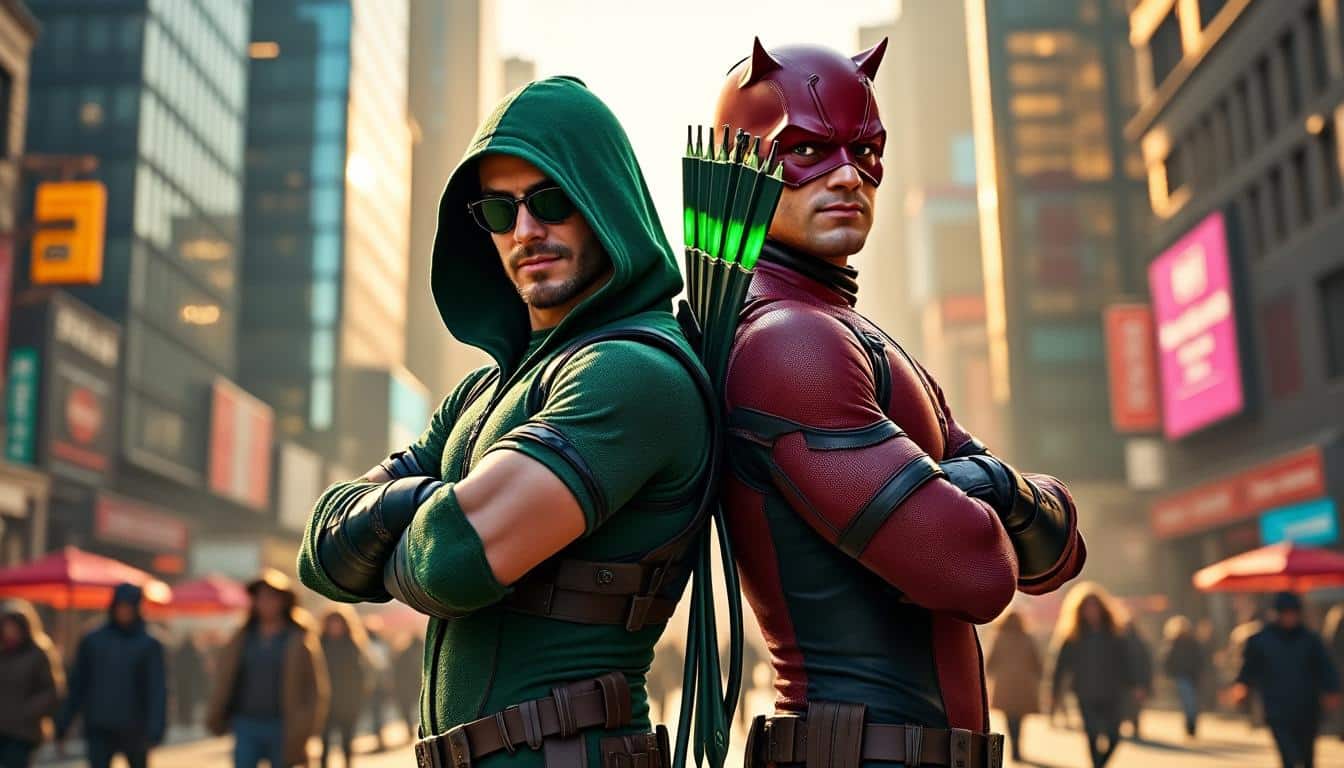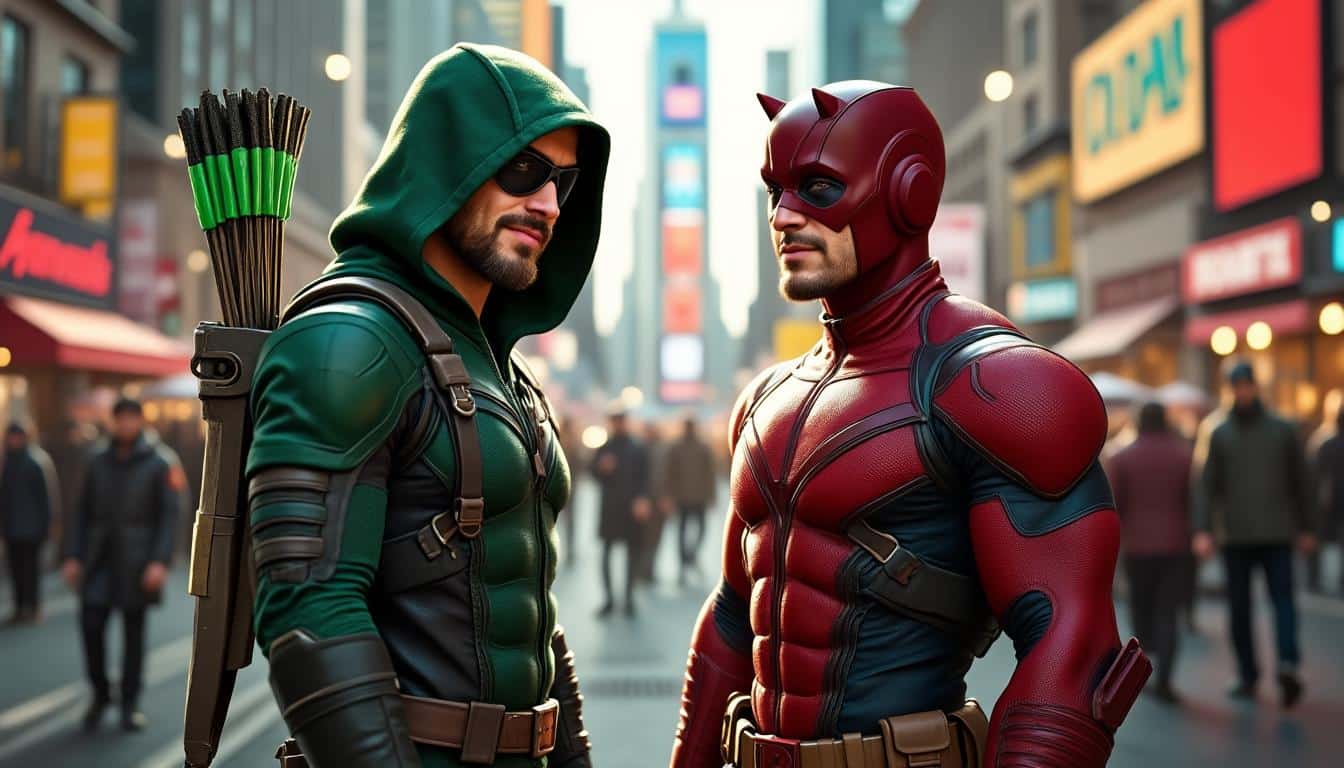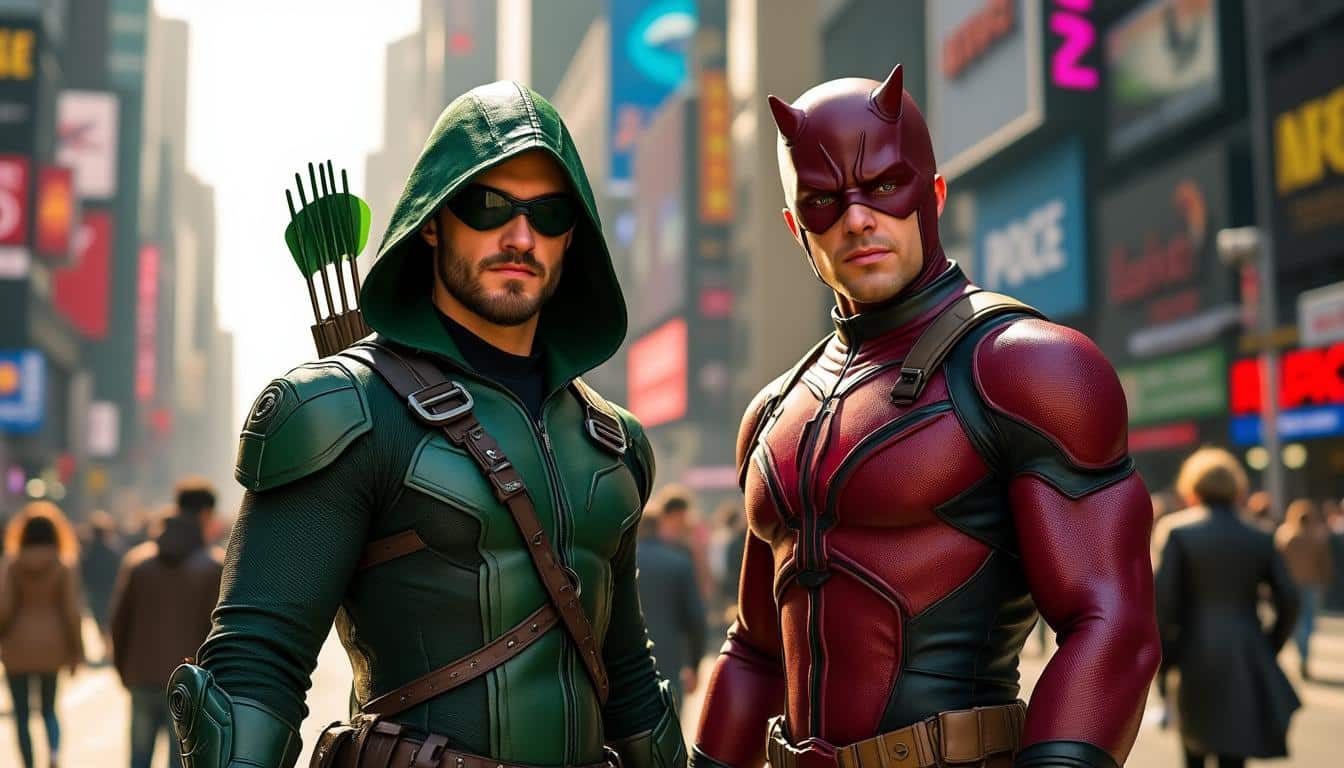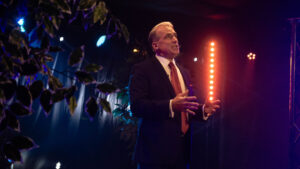Let’s meet two of my favorite superheroes: Green Arrow, aka Oliver Queen, and Daredevil, aka Matt Murdock. At first glance, they seem so different that it’s hard to imagine them as friends. Their personalities, one ESTP and the other INFJ, shape completely distinct realities.
Although Green Arrow operates in California and Daredevil in New York, their worlds seem almost alien to each other. Why talk about superheroes while exploring personality types? Because superheroes embody our most cherished values and deepest aspirations, as well as our darkest fears. They are an amplified version of ourselves, larger than life, forcing us to confront our true identity and real desires. Let’s therefore explore the foundations of the Myers-Briggs system through these two heroes and compare their characteristics.
Extravert vs Introvert
Green Arrow is an obvious extravert. He enjoys being in the spotlight and draws his energy from large crowds, especially during parties at his family mansion. He takes charge of organizing the family Christmas party. He opens a nightclub and feels perfectly comfortable with the constant attention he receives as the life of the party.
In contrast, Daredevil is an introvert who draws his energy from solitude, retreating, recharging, and meditating on existential questions like why God allows so much evil in Hell’s Kitchen. Just like Green Arrow, Daredevil leads a double life, but he is much more comfortable with his mind and heart, living in a private world where he gains his strength before emerging to confront villains.
Sensing vs Intuition
Green Arrow is a Sensing type who lives in the moment. He loves loud music and lively conversations at a party. He is tangible, living in the physical world.
Daredevil, on the other hand, though blind, relies on his Intuition to read situations and people, using his inner sense to navigate and connect the dots in any situation.
Thinking vs Feeling
Green Arrow, while deeply caring about his friends and family, mainly uses the Thinking function when a quick decision is needed. He favors logic and efficiency in his actions, sometimes at the expense of emotions.
Daredevil, as a Feeling type, is constantly torn by his values and the conviction that he might do more harm than good. His decisions are guided by what he feels is right, even in the most critical moments.
Judging vs Perceiving
Green Arrow is a Perceiver, capable of changing direction in an instant, easily adapting to new circumstances that arise during his fights.
Daredevil is a Judger, more orderly and methodical. Every move is deliberate, using his martial arts skills to anticipate and counter his opponents.
Emotional Stability and Neuroticism
Neuroticism is not explicitly addressed in the Myers-Briggs system, but it is essential for understanding the emotional stability of each hero. Green Arrow displays great self-confidence, even if he carries regrets, while Daredevil often finds himself engulfed in worry and doubt, making him constantly vigilant and determined to protect those he loves.
A Deeper Look
These two crime fighters can be seen as an actor and a visionary, each having a different subjective experience of reality. Their dominant cognitive functions, Introverted Intuition (Ni) of Daredevil and Extraverted Sensing (Se) of Green Arrow, profoundly shape their perception of the world and their interactions.
Relationships
Green Arrow forms strong relationships with those who share his physical skills and direct approach, while Daredevil bonds with individuals who share his vision for a just and peaceful city.
Before a Fight
Before fighting, Green Arrow acts instinctively, reacting to the present moment without much thought, whereas Daredevil analyzes and meticulously plans each move before acting.
Ultimate Goal
Both heroes aspire to a city where their vigilante services are no longer needed, but their visions of this utopia differ: a lively and festive city for Green Arrow, and a place of justice and safety for Daredevil.
The Real Message
The real purpose of this comparison is not to talk about superheroes, but to illustrate a fundamental idea: to understand and appreciate personality differences. Isabel Myers and Katharine Briggs created the theory of 16 personality types to help individuals better understand themselves and build bridges despite their divergences.

Green Arrow and Daredevil embody two diametrically opposed personalities that might seem incompatible at first glance. Green Arrow, aka Oliver Queen, is an energetic extravert who draws his strength from social interaction and direct action. He intensely lives in the moment, enjoying physical challenges and the adrenaline of fighting. His approach is pragmatic and oriented towards rapid problem-solving, reflecting his pragmatic and adaptable character.
In contrast, Daredevil, or Matt Murdock, is a reflective introvert who finds his energy in solitude and contemplation. His intuitive perception allows him to understand complex situations and navigate moral nuances with deep empathy. Leaning towards feeling rather than rational thought, Daredevil is guided by his values and desire for justice, often in internal conflict with the methods he chooses.
Despite these stark differences, Green Arrow and Daredevil can become unlikely friends by relying on their complementary strengths. Their collaboration brings together Oliver’s direct action with Matt’s strategic vision, demonstrating that opposing personalities can not only coexist, but also mutually enrich their shared fight for justice.

The comic book universes are full of fascinating duos, often made up of characters with contrasting personalities. Among them, Green Arrow and Daredevil stand out due to their deep differences. Green Arrow, the lean archer from California, embodies liveliness and extraversion, while Daredevil, the blind defender of New York, represents introspection and intuition. This duality raises a captivating question: can such opposing personalities really develop a strong, unlikely friendship? This article explores the potential dynamics between these two heroes, analyzing their character traits, motivations, and the challenges they might overcome to forge an alliance. Through this exploration, we will highlight how their differences can not only separate them but also bring them together, offering an enriching perspective on interpersonal relationships in the superhero world.
The contrasting personalities of Green Arrow and Daredevil
Green Arrow, whose real name is Oliver Queen, is often seen as a charismatic extravert, drawing his energy from social interactions and events gathering large crowds. His dynamic nature and ease in public situations allow him to connect easily with others and take bold initiatives. In contrast, Daredevil, aka Matt Murdock, is a reflective introvert, finding his strength in solitude and inner meditation. His life experience as a blind lawyer has endowed him with heightened sensitivity and deep intuition, allowing him to perceive nuances that others might overlook. These fundamental differences in how they perceive the world and interact with it raise the question of their compatibility as potential friends. However, these contrasts can also become the key to a balanced alliance, combining external strength and internal depth.
The motivations that drive them
The motivations of Green Arrow and Daredevil are also divergent, though both are justice-oriented. Oliver Queen is motivated by a desire to right the wrongs of his past and to proactively and visibly protect his hometown. His engagement in social causes and direct involvement in fighting crime reflect a pragmatic and tangible approach to justice. In contrast, Matt Murdock is driven by a more philosophical quest for justice, seeking to establish moral balance in a world often marked by gray areas. His role as a lawyer allows him to combat injustices in a subtle and systemic way, influencing laws and defending the innocent. These contrasting motivations offer a potential complementarity, where Green Arrow’s direct action can combine with Daredevil’s thoughtful strategy to create powerful synergy in their fight against evil.
The challenges of communication between two worlds
Communication between two such different personalities can be a major challenge. Green Arrow, accustomed to frankness and quick action, might find it difficult to understand Daredevil’s slower, more introspective methods. Matt, on his part, may feel frustrated by Oliver’s immediate lack of reflection and his tendency to act impulsively. These differences can lead to misunderstandings and tensions within their relationship. However, if both heroes manage to develop open communication and respect each other’s approaches, they can learn to leverage their respective strengths. For example, Oliver might learn to value Matt’s strategic planning and depth of thought, while Matt could gain increased confidence in Green Arrow’s direct action and responsiveness. This mutual adaptation would be essential to overcoming obstacles and strengthening their unlikely friendship.
Complementarity of skills
Beyond personal differences, Green Arrow and Daredevil possess complementary skills that could enhance their collaboration. Oliver, with his archery expertise, combat skills, and ability to orchestrate complex operations, brings an indispensable tactical and strategic dimension. On the other hand, Matt has heightened sensory skills, mastery of martial arts, and the ability to anticipate his opponents’ movements thanks to his intuition. Together, they can cover a wide range of situations, combining Oliver’s precision and brute strength with Matt’s tactical finesse and strategic analysis. This complementarity could not only improve their effectiveness as superheroes but also strengthen their mutual trust, thereby facilitating the development of a solid friendship despite their differences.
The impact of their geographic origins
The distinct geographic origins of Green Arrow and Daredevil also play a crucial role in their relational dynamic. Oliver Queen is deeply rooted in Californian culture, with its social influences and dynamic lifestyle. This influence is reflected in his optimistic and proactive approach to challenges. In contrast, Matt Murdock is shaped by the intense and complex atmosphere of New York, a constantly evolving metropolis where justice is often subjective and difficult to achieve. This difference in living environment can influence their perception of problems and the way they approach solutions. However, these varied origins can also enrich their collaboration by bringing diverse perspectives and expanding their understanding of different urban realities. Thus, their unlikely friendship can benefit from cultural richness and depth of experience, reinforcing their ability to confront the threats looming over their respective cities.
The shared values and points of convergence
Despite their differences, Green Arrow and Daredevil share fundamental values that can serve as a bridge between their opposing personalities. Both are driven by a deep sense of justice and a desire to protect the innocent. This shared devotion to defending the oppressed and fighting against evil provides a solid foundation for their friendship. Moreover, their willingness to sacrifice their own well-being for the sake of others demonstrates a similar altruism and moral commitment. These shared values can help them overcome divergences in their methods and focus on their common goals. By recognizing and respecting these points of convergence, they can build a relationship of trust and mutual support, essential for navigating the complex challenges they face as superheroes.
The mutual lessons and personal growth
A friendship between Green Arrow and Daredevil would also offer an opportunity for personal growth and mutual learning. Oliver could learn from Matt the importance of introspection and patience, developing a more nuanced approach to challenges. Matt, in turn, could benefit from Oliver’s energy and flexibility, learning to be more adaptable and responsive in unforeseen situations. This interaction could encourage each to step out of their comfort zones and adopt new perspectives, enriching their personal development and effectiveness as heroes. Moreover, this relationship could serve as a model for other superheroes, demonstrating that contrasting personalities can not only coexist, but also mutually enrich each other. Thus, their unlikely friendship could become an inspiring example of collaboration and interpersonal understanding.
The external challenges and the need for unity
The powerful enemies and complex threats faced by Green Arrow and Daredevil often require close collaboration between different heroes. External challenges, such as sophisticated criminal organizations or supernatural threats, can force these two heroes to set aside their differences to unite their strengths. This necessity for unity in the face of common adversaries can strengthen their unlikely friendship, creating strong bonds based on trust and cooperation. For example, by facing an enemy that threatens both Star City and Hell’s Kitchen together, they can realize that their diversity is a strength rather than a weakness. This collaboration could not only enhance their effectiveness as superheroes but also cement their friendship, showing that unity in the face of adversity can transcend personal differences.
Conclusion: A possible friendship despite differences
Despite their contrasting personalities and divergent approaches to justice, Green Arrow and Daredevil have the potential to forge a strong and unlikely friendship. Their differences can not only enrich their relationship but also enhance their effectiveness as superheroes. By sharing common values and mutually learning from their experiences, they can overcome the challenges of communication and mutual understanding. Furthermore, in the face of external threats, their collaboration could demonstrate that unity and diversity are valuable assets. Thus, the friendship between Green Arrow and Daredevil perfectly illustrates how opposing personalities can not only coexist but also elevate each other, offering an inspiring perspective on interpersonal relationships and collaboration in the complex world of superheroes.

“`html
FAQ
Q: What are the personality traits of Green Arrow and Daredevil according to the MBTI?
A: Green Arrow is an ESTP extravert, while Daredevil is an INFJ introvert, which makes them very different in terms of personality traits.
Q: How do Green Arrow and Daredevil illustrate the differences between Extraversion and Introversion?
A: Green Arrow, as an extravert, loves being the center of attention and gains energy from large crowds. Daredevil, as an introvert, recharges in solitude and prefers quieter environments.
Q: How do the dominant cognitive functions of Green Arrow and Daredevil influence their approach to fighting crime?
A: Green Arrow uses Extraverted Sensing to react quickly and stay in the moment, while Daredevil uses Introverted Intuition to analyze and plan his actions carefully.
Q: What are the ultimate dreams of Green Arrow and Daredevil for their city?
A: Green Arrow dreams of a joyful and safe city, while Daredevil aspires to a city based on justice and fairness for all its inhabitants.
Q: Why are superheroes used to explore personality types?
A: Superheroes embody our values, aspirations, and fears, making them ideal for illustrating and exploring different personality types.











